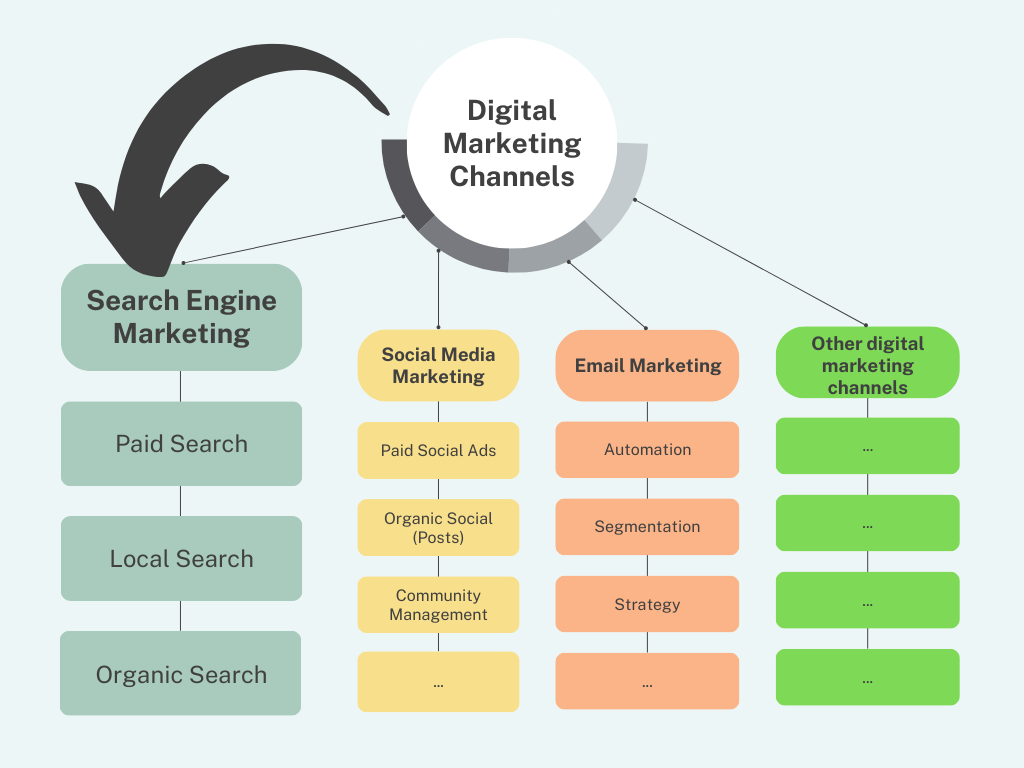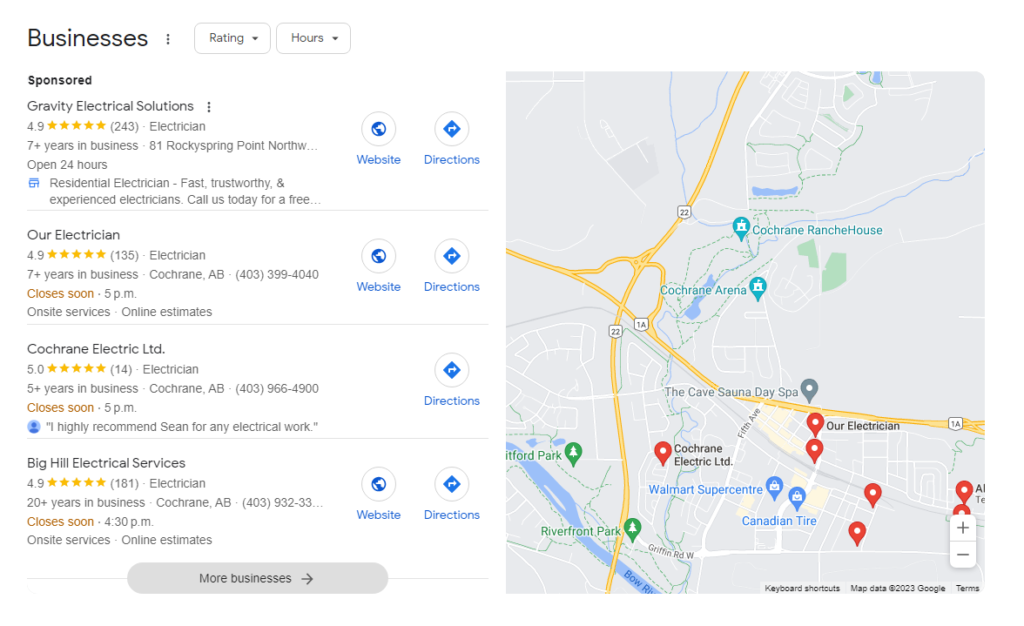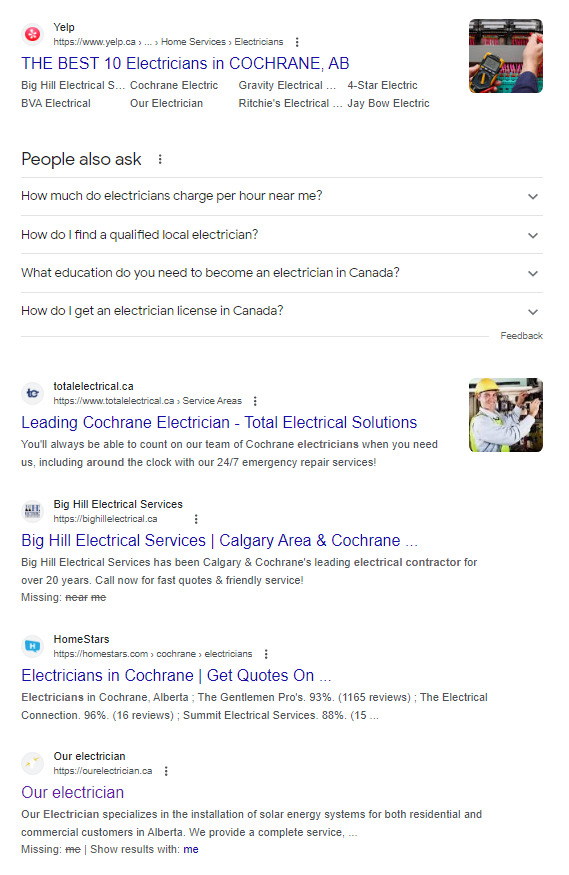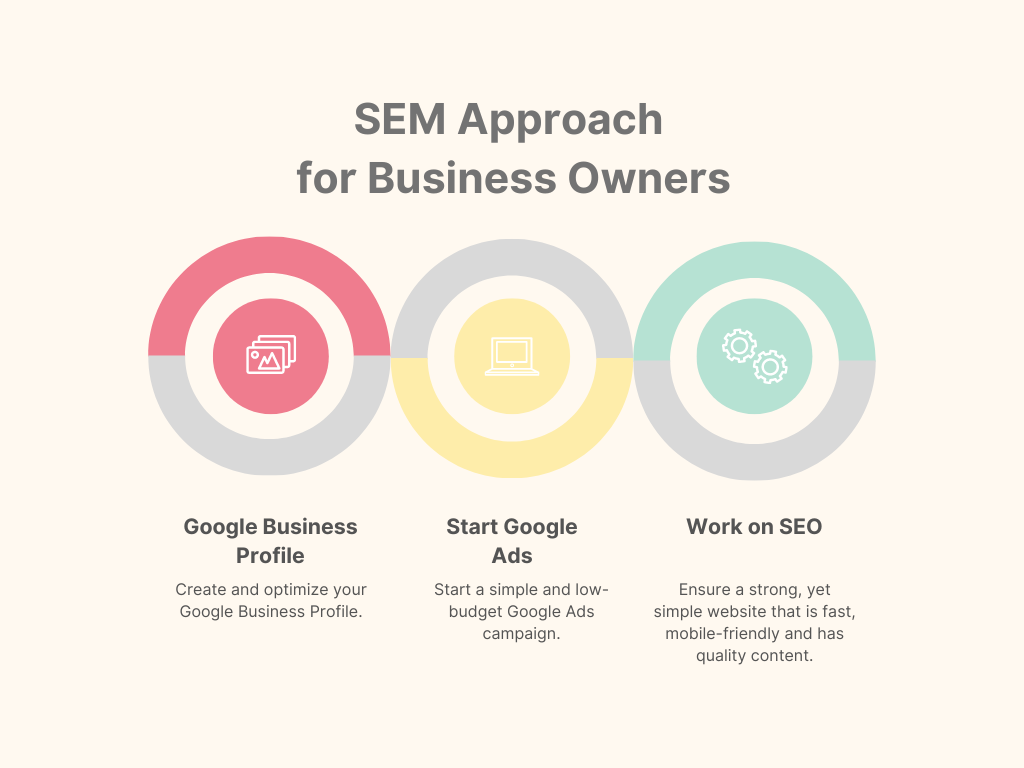Learn about SEM, its place in digital marketing and its elements.
Let’s first place search engine marketing (SEM) in a broader field of digital marketing.

What is SEM?
SEM is a digital marketing strategy to increase website traffic and brand visibility through paid advertising and optimization. Unlike social media or display ads, SEM targets users actively searching for products or services.
Imagine you own a small bakery. Search Engine Marketing (SEM) is like placing ads so your bakery shows up when people search for “best cupcakes near me” on Google. It’s about getting your business noticed by people who are looking for what you offer.
How is SEM different from other digital marketing channels?
People move through awareness, consideration, and decision-making stages in the customer journey. SEM focuses on reaching potential customers when they actively search for products or services, making it a crucial part of their journey.
In contrast, social media marketing and banner ads are not always there when your customers search.
Benefits of SEM
Search engine marketing offers unique advantages compared to other digital marketing channels:
- Intent-based targeting: SEM allows you to reach customers at the moment when they’re actively searching for a solution.
- Quick visibility: With Google Ads, businesses can start showing up in search results relatively quickly, usually within 1-2 days of starting the campaign.
- Measurable results: SEM allows businesses to track results and measure ROI through metrics like click-through rates and conversions.
- Targeted local reach: SEM offers opportunities to local businesses to become visible on Google Maps.
- Flexibility and control: With Google Ads businesses control budget and how the ads appear in search results.
While social media marketing and display ads have their merits in building brand awareness and engaging audiences, SEM stands out for its precision targeting, immediate visibility, and measurable results, making it a powerful tool in a comprehensive digital marketing strategy.
SEM opportunities
There are three main opportunity areas in SEM: paid, local and organic search (natural search, search engine optimization or SEO).
- Paid search: Placing Google Ads in search results for specific keywords.
- Local search: Optimizing local business listings and websites for location-based searches.
- Organic search (SEO): Optimizing websites through technical adjustments, content development and link building.
Let’s look into each one of those areas in more detail.
Paid search

With paid search, when someone searches for “fresh pastries near me”, your bakery’s ad could appear at the top of the results, attracting potential customers to visit your website or store.
For a strong start with paid search, consider: 1) what target actions users will take when landing on your website after a click, 2) what’s the cost you are willing to pay for a conversion (desired customer action), 3) what are the keywords your customers might look for, 4) characteristics your customers look for in a trustworthy vendor.
Create your Google Ads account. We’ll dive into setting things up in one of the future articles.
Read a more detailed guide on paid search ads.
Local search

Imagine you operate a pet grooming service in San Diego, optimizing for local search means that when someone in San Diego searches for “pet groomers near La Jolla,” your business is more likely to show up in the local map pack, increasing visibility among local pet owners.
Remember that you should set up a Google Business Profile to get a local-pack listing (part of the top 3 results by the map).
Also note, to qualify for a Google Business Profile, you business should either…
- have a business location that customers visit,
- or service your customers at their location within a set geographic area.
For a strong start in local search, consider 1) creating a complete Google Business Profile, 2) generating reviews, 3) building business citations, and 4) optimizing your website for local rankings.
Read a detailed article about Local SEO.
Organic search (SEO)

Organic search results are generated using multiple algorithms to produce the most relevant results for the user search query. As a business owner, you don’t pay for clicks.
Getting your pages into the blue-link section of the SERPs commonly refers to SEO or search engine optimization.
Let’s say you manage a small landscaping business in Orange County. By optimizing your website with
- high-quality content about landscaping tips,
- using keywords like “best garden design in Orange County,”
- ensuring your website loads quickly,
- and earning backlinks from other websites
…you increase the chances of it appearing higher in organic search results.
For a strong start in SEO, consider 1) a solid technical foundation, 2) relevant content for your target audience, and 3) external websites linking to you (backlinks).
Read the article on starting SEO.
Getting started with SEM
It’s easy to get overwhelmed by the amount of details. So, here’s the roadmap. Start simple. Move slowly, step by step. Grow from there.
- First, create a Google Business Profile: Establish your business on Google for local visibility.
- Then, build a Google Ads campaign: Explore paid advertising with a small budget and targeted campaigns.
- Finally, work on optimizing your website for organic rankings (SEO): Enhance website content and structure for better organic search rankings.

In conclusion
SEM is a powerful tool for reaching customers. By understanding paid, local, and organic search, you can effectively grow your online presence.
Would you like to learn more about each area of SEM?
- Starting Google Ads (aka paid search)
- Starting Local SEO (search visibility for local businesses)
- Starting SEO (aka organic search)
